Tungsten: The perfect metal for bullets and missiles
- Published
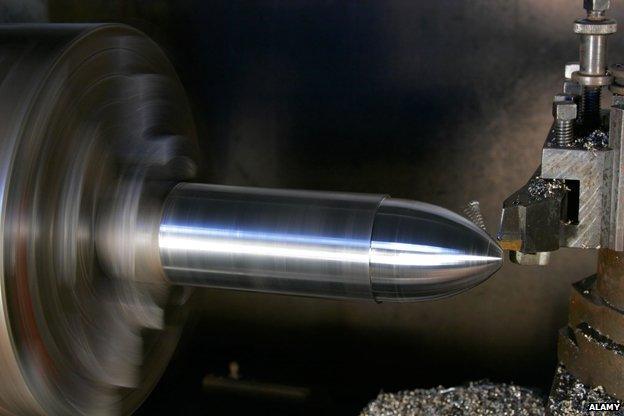
Imagine a lump of iron the size of a tennis ball. Weigh it in your hand. Now let it drop on to your foot. How does that feel? Now imagine an identical object three times as dense. How would that feel if you dropped it? Would you ever walk again?
That metal is tungsten.
As well as being incredibly dense it is also incredibly hard and has the highest melting point of all the elements at 3,422C.
A century or so ago the world had no use for it - it was almost impossible to shape or work the stuff. Yet now we use tungsten to write with, to traverse glaciers, to emit X-rays and to destroy buildings without the use of explosives.
To understand how this happened, we need to understand the competitive forces that have shaped everything in our world, and where better to start than a mystery at the heart of the evolution of life?
For the first four billion years, life didn't actually do much evolving. Organisms were small, simple and fairly rare. Then around 500 million years ago something extraordinary happened - the fossil records show there was an incredible explosion of life.

The Cambrian explosion
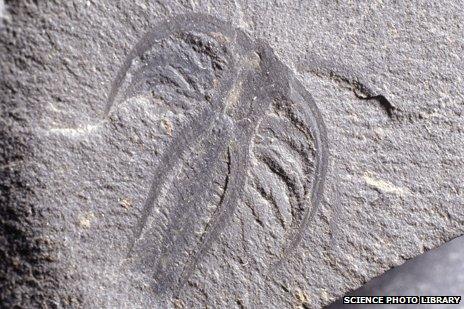
Refers to period which began about 545 million years ago when there was a sudden explosion of abundant and diverse life-forms
Characterised by appearance of many major phyla that make up modern animal life, external
Period saw the emergence of hard body parts - which can be seen in the fossil record
Prior to the Cambrian explosion, most organisms were simple

An extraordinary array of wonderful new organisms appeared. There are saucer-eyed creatures with tentacles below and an arc of dramatic spines on their backs, there are squids with crab-like arms and strange things like floating air mattresses with a fringe of tiny waving fingers.
Charles Darwin reckoned what is known as the "Cambrian explosion" was the most powerful objection to his theory of natural selection. This abrupt flourishing of species went against the idea of gradual evolution.
So what could have caused it?
Many scientists now believe that this great proliferation of new life was driven by the development of what was, by Cambrian standards, an exotic new capability - theories include the eye, or even the anus.
Or how about teeth? Worm-like creatures with spikes around the entrance to their guts that first appeared during the Cambrian look fearsome even now, but just think what effective killers these predatorial jaws would make in a world of soft, vulnerable organisms.
And that's not all. The Cambrian is also when the shells and exoskeletons first appear in the fossil record in significant numbers. There is also the first evidence of burrows, of creatures digging into the sea floor.
"It is like finding the disturbing remains of an arms race - swords with shields, guns with tanks, bombs with bomb shelters - in an archaeological dig," the palaeobiologist Martin Brasier has written.
The theory is that the rest of creation had to adapt very rapidly to defend itself, hence the armour of calcium carbonate many creatures threw up, and why some animals evolved to dig themselves to safety.
Biologists call the process co-evolution.
So what has all this got to do with tungsten, you are probably wondering.
Well, the world of manufacturing involves its fair bit of co-evolution. New materials are developed - super strong alloys, for example - which mean something like an aeroplane or an electricity turbine can be made more resilient, and often lighter and cheaper too.
But stronger components require tougher tools to work them - and that is where tungsten comes in. Element 74 in the periodic table is one of the toughest substances in nature.

At SGS Carbide, a tool manufacturer just outside London, they use a lot of the stuff. They make a range of drill bits and cutting tools used in the aerospace, automobile and many other industries out of tungsten carbide - a super-hard compound of tungsten and carbon - cemented together with cobalt.
So how do you shape one of the most extreme materials on the planet?
You have to use the only thing tougher - diamonds. Even using diamond cutting tools the work involves an unholy battle, though you wouldn't know it inside SGS Carbide's factory. There's no smoke or sparks. All you hear is a quiet hum from the lathes and other machines.
Each one is contained in its own sound-proof box and has a sophisticated cooling system using refrigerated oil. But even with these state-of-the art machines it can take 10 minutes or more to cut a single drill bit. And they are expensive - a single drill bit can cost more than £500 ($750).
Yet, as more and more advanced alloys are used in industry, the demand for the super-strong, super-durable and super-accurate tools companies like SGS Carbide produce has grown. As most of the tungsten mined on the planet is used to make these tools, the price of the raw metal has been rising.
At the same time what may be tungsten's best-known industrial use now looks to be in terminal decline.
In a small room off one of the corridors of the chemistry department of University College London, Prof Andrea Sella holds up an old-fashioned incandescent light bulb. Through the clear glass I can see the fragile filament shiver as he gently shakes the bulb.
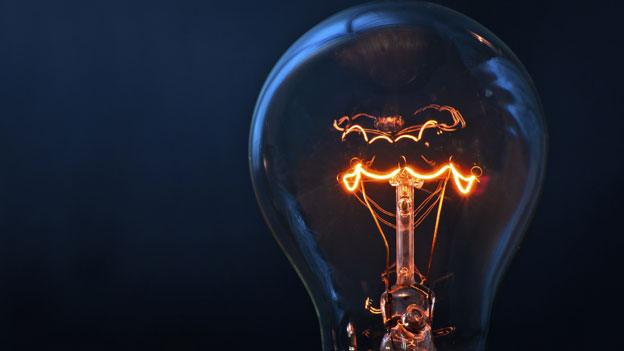
"The greater the current the hotter that little coil of tungsten gets and the brighter it glows," explains Sella.
Once, all our homes were illuminated by bulbs like these, but it took almost 100 years of trial and error to settle on tungsten. The great scientists and inventors who developed the first light bulbs tried out filaments of platinum, iridium, carbonised sewing thread and even bamboo - the latter both innovations of Thomas Edison's.
Then in 1908 another great American inventor, William D Coolidge, finally figured out how to make wires out of ultra-tough tungsten. These proved ideal filament material - strong, durable and heatable to extreme brightness without melting.
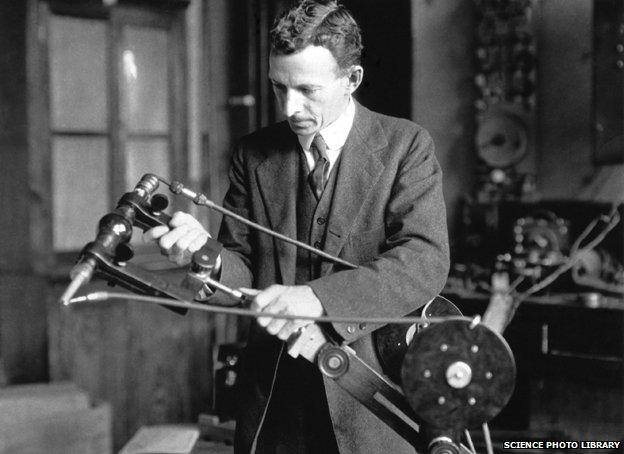
Tungsten filaments served us well for a century but the truth is they were always much better at producing heat than light - in some bulbs as much as 97% of the energy was lost as heat. That's why across the world incandescent bulbs are now being replaced by far more efficient compact fluorescents, light emitting diodes and other technologies.
But tungsten is still the basis of the two crucial technologies that help us see the world in very different ways.
Tungsten filaments generate the X-rays that give us a view inside our bodies and bones, and also the welds that hold ships, planes and bridges together. It is also used to form the emitter tips of the electron guns that allow electron microscopes to peer down and examine objects as tiny as single molecules.
But it was tungsten's density that earned it its name - it comes from the Swedish tung sten, heavy stone.
It is almost three times as dense as iron, almost twice that of lead and virtually the same as gold.
And, like the proliferation of new species during the Cambrian explosion, all sorts of weird applications have evolved to exploit tungsten's unique qualities.
It is used in the spikes in the drive tracks of snowmobiles, the vibrators that wobble our mobile phones when they ring, weights for fishing tackle, the balls of ballpoint pens, and professional darts.
It is also why fraudsters have sometimes managed to make themselves an easy profit by passing off gold plated bars of tungsten as the real thing. And its density and hardness is why the military has called tungsten into service in another kind of evolutionary arms race.
"Tungsten makes very good bullets," the military analyst Robert Kelley tells me. "It is the kind of thing that if you fire it at someone else's armour, it will go right through it and kill it."
And just like the creatures of the Cambrian period, once someone starts using teeth (or tungsten bullets) you need to do something about it.
"If you introduce tungsten into your bullets you've got to introduce tungsten into your armour," says Mr Kelley.
He describes the fascinating balance military engineers have to negotiate between the strength of tungsten and the costs in fuel and manoeuvrability all that extra weight brings.
"They'll put the tungsten on the side of the tank but not on the top. So then people will develop warheads that will fly towards the tank and then at the last minute go up and then drop on it, so then you have to start arming the top of the tank.
"So it is a constant game of give and take."
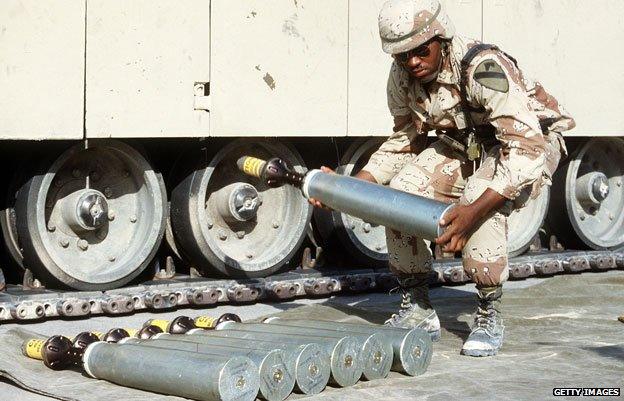
Armour-piercing sabot rounds used in the 1990-91 Gulf War
And tungsten's extraordinary properties have led to the development of a class of missiles that work without explosives.
"Kinetic bombardment" weapons involve firing what are, in effect, spears of tungsten at incredible speed towards your target. They can penetrate thick steel armour and cause terrific, but very localised, devastation.
Tungsten's only rival for this kind of application is the radioactive element uranium. Depleted uranium is (almost) as dense as tungsten and has an added advantage - from a military perspective - that it burns at the extreme temperatures generated as you punch your way through steel tank armour.
That will often blow up any explosives in the tank.
"Put it this way, if you are the guy inside the tank, you will not remember what happened," says Kelley bluntly.
So why does the military still use tungsten if uranium has this macabre, but useful additional property?
Because, as the people of Kuwait discovered after first Gulf War, depleted uranium leaves a potentially deadly dust behind after it burns. It sounds bizarre but, in the world of warfare, tungsten is the eco-friendly alternative.
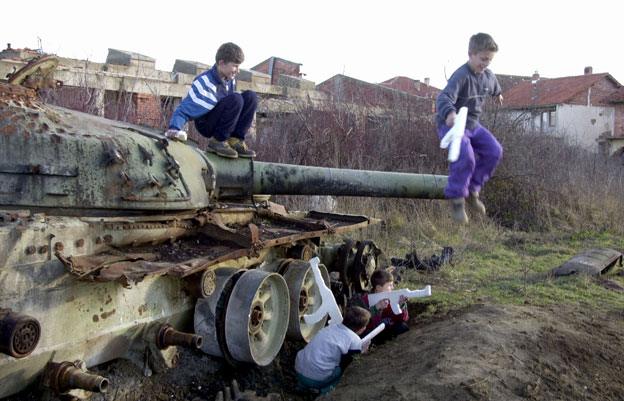
Depleted uranium was also used in Kosovo
All these evolving military and industrial uses explain why tungsten is classified as a critical strategic element by many nations.
Yet more than 80% of world supply is controlled by China, and in recent years China has imposed restrictions on the export of tungsten - along with many other raw commodities. It wants to encourage the development of the hi-tech industries that use tungsten within China itself.
That's also helped to push prices up, making previously uneconomic non-Chinese deposits worthwhile to mine.
Hemerdon, on the edge of Dartmoor, is the first new metal mine to be opened in Britain for 40 years, and will exploit the world's third largest tungsten deposit.
It is being re-opened by a company called Wolf Minerals, named after "wolfram", an alternative name for tungsten and why the element is represented by a W in the periodic table. (In fact, "volfram" is the name used in Sweden, where "tungsten" refers to Scheelite, calcium tungstate.)
This new mine is another manifestation of the competitive pressures that shape the modern world and - as we have discovered - drove evolution in the primordial world too.
Though ironically the rocks they'll be mining at Hemerdon are much younger than the Cambrian - a mere 400 million years old.
Subscribe to the BBC News Magazine's email newsletter to get articles sent to your inbox.